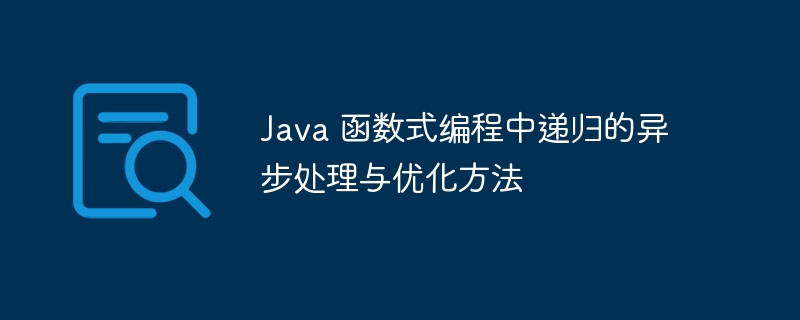Java 函数式编程中递归的异步处理与优化方法
在 java 函数式编程中,递归异步处理可用于高效执行复杂的异步流程,但需要优化以避免堆栈溢出。通过尾递归优化,可以避免在堆栈上累积调用。为了进一步优化,可以使用堆栈帧异步化技术,将尾递归调用封装在单独的 completablefuture 中,从而提高性能。

Java 函数式编程中递归的异步处理与优化方法
在 Java 函数式编程中,递归异步处理可用于异步执行代码块,通过结合递归和异步编程,可以实现复杂的异步流程。但是,如果没有适当的优化,递归异步处理可能会导致堆栈溢出或其他性能问题。
实战案例
考虑以下异步处理文件列表并将它们的内容追加到一个单个文件的场景:
List<File> fileList = getListOfFiles();
for (File file : fileList) {
readFileAsync(file).thenApply(content -> appendToFile(content));
}这是一个简单的同步处理,它会阻塞当前线程,直到所有文件的内容都追加到目标文件中。为了使此过程异步化,我们可以使用 CompletableFuture:
List<CompletableFuture<Void>> futures = new ArrayList<>();
for (File file : fileList) {
futures.add(readFileAsync(file).thenApply(content -> appendToFile(content)));
}
CompletableFuture.allOf(futures.toArray(new CompletableFuture[0])).join();这将并行处理文件,但仍会阻塞当前线程,直到所有文件都得到处理。
递归异步处理的优化
为了避免堆栈溢出,我们可以使用尾递归优化:
public CompletableFuture<Void> handleNextFile(List<File> fileList) {
if (fileList.isEmpty()) {
return CompletableFuture.completedFuture(null);
}
File nextFile = fileList.get(0);
return readFileAsync(nextFile)
.thenApply(content -> appendToFile(content))
.thenCompose(aVoid -> handleNextFile(fileList.subList(1, fileList.size())));
}这种方法使用递归调用来处理下一个文件,同时避免在堆栈上累积调用。
优化尾递归的异步处理
除了尾递归优化之外,还可以通过使用堆栈帧异步化技术进一步优化异步处理。这涉及将尾递归调用包装在单独的 CompletableFuture 中,以避免在堆栈上累积调用。
public CompletableFuture<Void> handleNextFileWithStackFrameOptimization(List<File> fileList) {
if (fileList.isEmpty()) {
return CompletableFuture.completedFuture(null);
}
File nextFile = fileList.get(0);
return CompletableFuture.supplyAsync(() -> {
readFileAsync(nextFile);
return handleNextFileWithStackFrameOptimization(fileList.subList(1, fileList.size()));
});
}这种优化通过避免在堆栈上累积额外的调用帧来提高性能。
以上就是Java 函数式编程中递归的异步处理与优化方法的详细内容,更多请关注其它相关文章!
